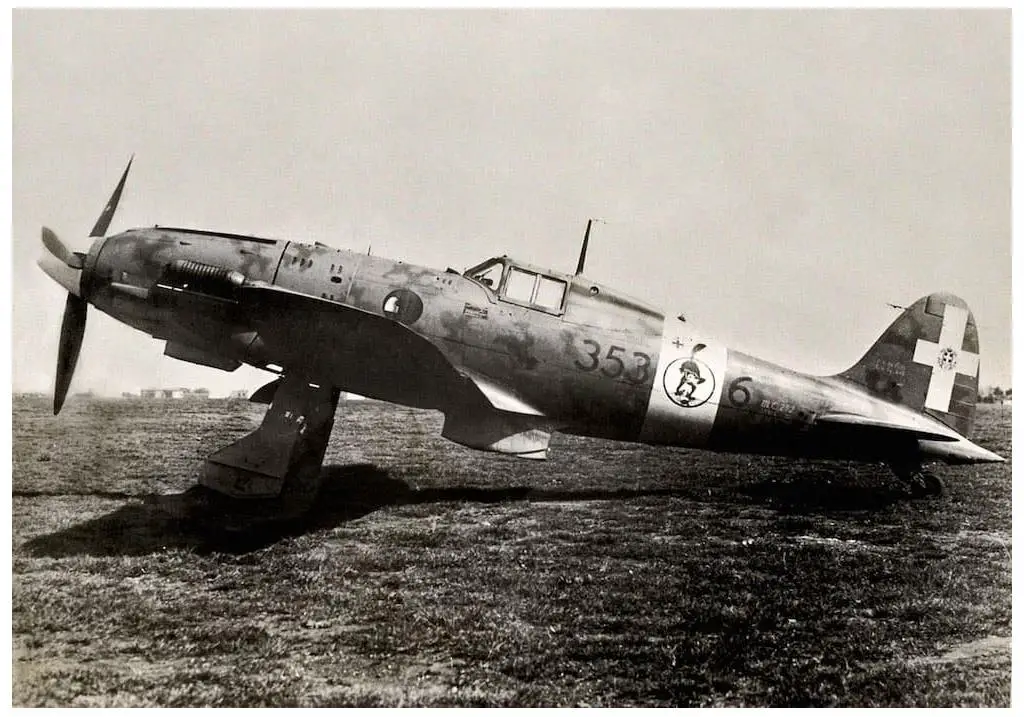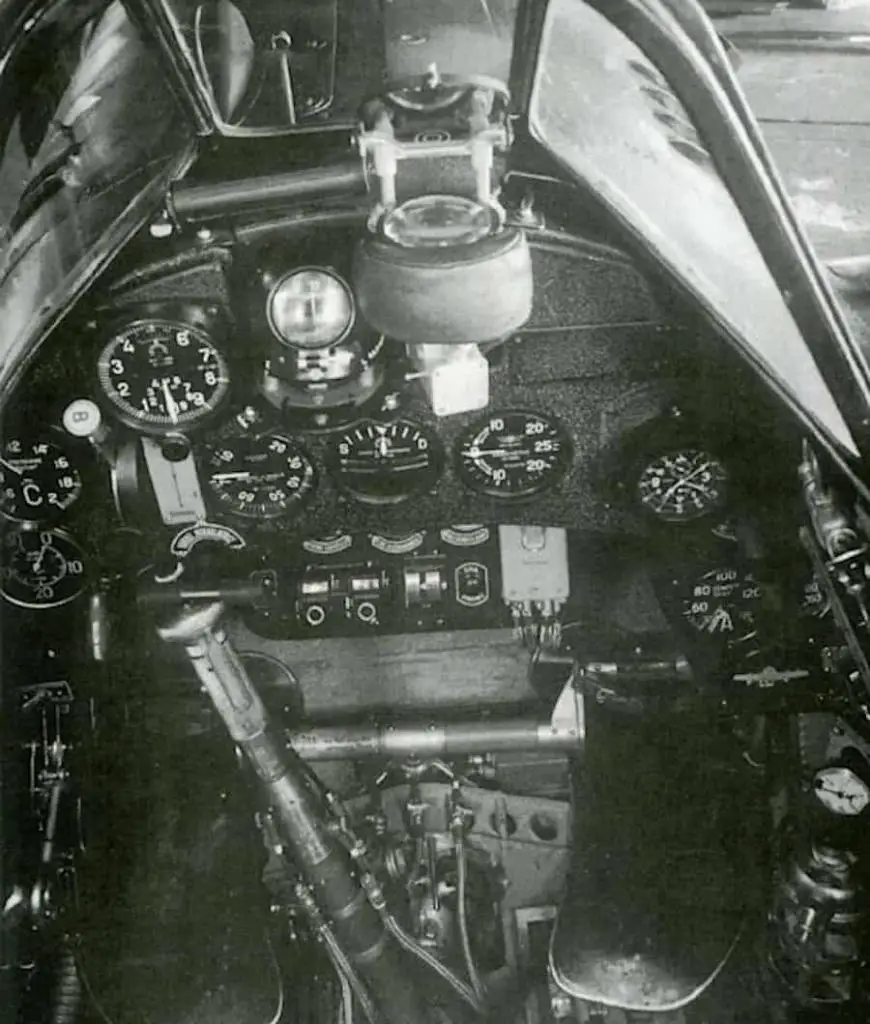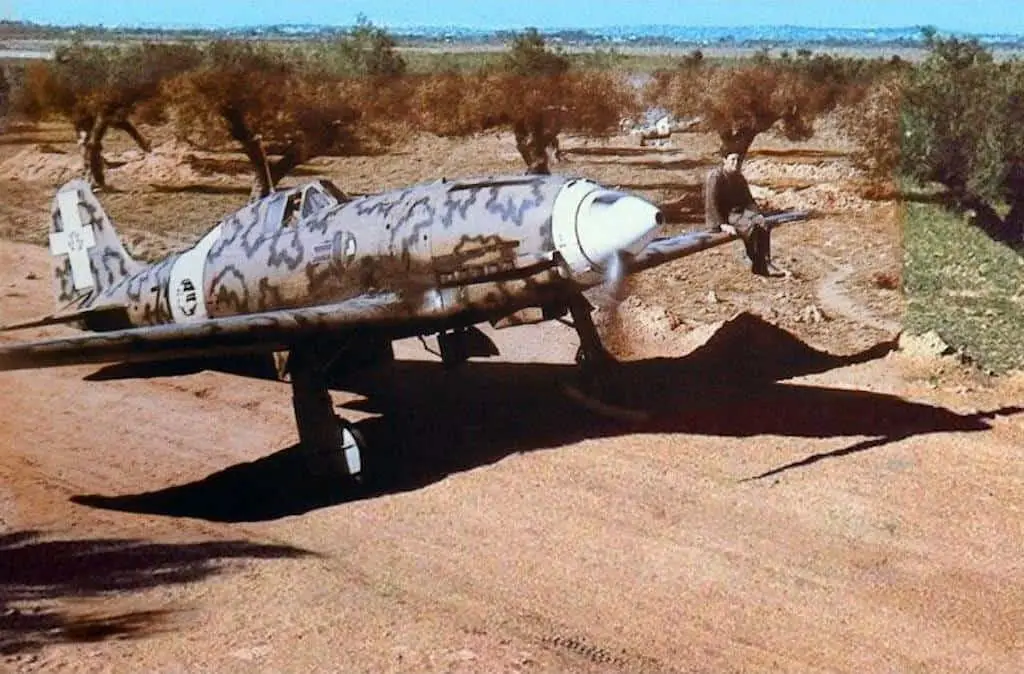Background on the Macchi C.202 Folgore
Throughout the ’20s and ’30s, Italy was a leading air-faring nation, producing excellent aircraft and famous theorists. Italy was one of the first nations to establish an independent air arm, equal to the army and navy. However, this lead began to dissipate with the rise of the all-metal monoplane, a challenge to the limited Italian industry. While Italian biplanes enjoyed fantastic maneuverability, they could not keep pace with the superior speed and firepower of monoplanes. The MC.200 Saetta designed by Mario Castoldi in 1937 represented Italy’s best foot forward into creating a modern, monoplane dogfighter. While it enjoyed excellent flight characteristics, it also lacked a sufficiently powerful engine for dogfighting. It was suitable in the ground attack role but struggled against its contemporaries. It was this deficiency that led to the development of the Macchi C.202 Folgore.

Macchi C.202 in 1943.
Upgrading the C.200 Saetta
The solution was to take the Saetta airframe and use it as the foundation for a new fighter. First of all, the cockpit became enclosed. Other minor modifications were made to accommodate a more powerful licensed built Daimler-Benz 601Aa engine. Swapping the old, radial engine for the German-designed, inline Daimler-Benz produced temendous performance gains. The fuselage was also streamlined to eliminate unnecessary drag as well as to house the new engine. Where the Saetta’s top speed was only 504 km/h, the Macchi C 202 Folgore enjoyed a top speed of about 600 km/h. From its combat introduction in 1941, the Folgore would grow into the backbone of the Italian fighter forces. In fact, it became regarded as one of the best Italian fighter aircraft of World War Two.

A 1943 photograph of a Macchi C.202 pilot of the 168th Squadron in Tunisia speaking to his ground crew.
General Characteristics
The Macchi C.202 Folgore was a single-engine, single-seat fighter. Dimensions of the frame measured 8.85m in length, 3.03m in height, and with a wingspan of 10.58m. The area of the wings was 16.82 m2, with an empty weight of 2,350 kg and a max takeoff weight of 2,930 kg. Armament was somewhat light, with the standard weapon layout consisting of two 12.7 mm Breda-SAFAT machine guns. This light armament was the chief shortcoming of the Folgore and represented no improvement over some early 30s designs. While the plane could be loaded with an extra pair of 7.7 mm machine guns, this necessitated adding weight for a marginal amount of firepower. Generally, pilots did not consider it adequate compensation for the decreased speed and range that weight brings. As such, it was rarely flown in the four machine gun configuration.

Macchi 202 instrument panel used for VII and XI series Folgore. Image: Aer.Macchi.
Daimler-Benz 601Aa Powerplant
These specifications were near-identical or identical to the Saetta. Minor differences from the Saetta include adding a retractable tailwheel and including an enclosed cockpit. The main difference is the powerplant, which required a redesigned forward fuselage. The fuselage housed a Daimler-Benz 601Aa liquid-cooled, inline engine built under license as the Alfa Romeo RA.1000 R.C.41-I Monsone. This generated over 1,150 hp, as compared to the 870 hp radial engine that had powered the Saetta. Besides the 600 km/h speed, the MC. 202 Folgore possessed an operational range of 765km.
In addition to strong speed, it carried over the fantastic climb rate and maneuverability of the Saetta. However, the relatively light armament was unsuitable, which ultimately gave a slight edge in dogfights to the Allied fighters such as the P-51 and Spitfires carrying more armament.
Production
The first MC. 202 Folgore models were completed on 10 August 1940. After almost a year, the MC. 202 entered combat over North Africa in July 1941. While there was an initial shortage of Daimler-Benz and Alfa Romeo inline engines, production of the Folgore rapidly grew. By November 1942, it made up the bulk of Italian fighter forces. With over 1,500 produced, it was the most heavily produced Italian airframe for the duration of the war. In fact, manufacturers Breda and SAI-Ambrosini assisted in building this highly desired aircraft under license.

A 1943 photo of a Macchi C.202 of the 17th Gruppo in Pantelleria.
MC.202 Series and Variants
- Series I included 100 aircraft (MM7859 to MM7958). Built by Breda between July 1941 to March 1942. This aircraft differed slightly with the prototype. Changes include a forged engine mount and fixed tailwheel.
- Series II included 10 aircraft (MM7709 to MM7718). Built by Macchi between May 1941 to April 1942. Similar to Series I.
- Series III included 140 aircraft (MM7719 to MM7858). Built by Macchi between May 1941 to April 1942. Also known as C.202 A.S. (Africa Settentrionale). Aircraft was fitted for tropical climates which include dust filters, oil coolers, cooling vents, and additional air intakes.
- Series IV included 50 aircraft (MM7409 to MM7458). Built by SAI-Ambrosini between November 1941 to April 1942 and similar to Series III.
- Series V included 50 aircraft (MM7959 to MM8008). Built by SAI-Ambr0sini between May 1942 to July 1942 and included upgraded San Giorgia type C reflector gunsights.
- Series VI included 50 aircraft (MM8081 to MM8130). Built by Breda during spring of 1942.
- Series VII included 100 aircraft (MM9023 to MM9122). Built by Macchi between April 1942 to July 1942. This aircraft was fitted with (2) 7.7 mm Breda-SAFAT machine guns or alternatively two 50-150 kg bombs or fuel tanks. Also known as the C.202CB CB (Caccia Bombardiere).
- Series VIII included 50 aircraft built by Breda (MM83339 to MM8388) between March 1942 to July 1942.
- XI Series included 100 aircraft built by Breda (MM9389 to MM9490) between September 1941 to February 1942.
- Series X included 100 aircraft built by Breda (MM9500 to MM9601) between July 1942 to September 1942.
- Series XI included 150 aircraft built by Breda (MM9602 to MM9753) between November 1942 to April 1943. Changes included a new horizontal tail and venture moved to the starboard side of the fuselage below the Macchi 202 cockpit.
- Series XII included 150 aircraft built by Breda (MM91803 to MM91952) between May 1943 to September 1943. Similar to the XI series.
- C.202bis is the initial identifier of what would become the Macchi C.205.
Macchi c.202 in Action
Between 1941 and 1942, it outclassed Allied fighters such as the Hawker Hurricane II and Curtis P-40. Later on, the Spitfire and Mustang were broadly superior, but not by such a margin that a Folgore pilot couldn’t confidently engage them. On the Eastern Front, the Folgore first arrived in September 1942. Only 17 Folgore aircraft participated in this theatre. Because of the adverse weather conditions, very few sorties were carried out.

A color photo of the Macchi MC.202 Folgore attached to the 81ª Squadriglia, 6° Gruppo, 1° Stormo CT in Libya.
The Folgore enjoyed a strong record as a dogfighter. During the air war over Malta, the 51° Stormo held an edge with the MC.2o2 over many Allied adversaries. In all, the 51° Stormo claimed 97 aircraft for a loss of 17 of their own. The Folgore also conducted reconnaissance flights and attacked supply convoys around Malta.
On the North African front during the summer of 1942, C.202’s outperformed and achieved a greater kill/loss ratio than their Bf109 counterparts. In fact, many Italian Aces flew the Folgore.
Post War Use
However, the heyday of the Folgore didn’t last very long. With the arrival of the Allied invasion and armistice in 1943, production and use declined. The Croatian air forces used some Macchi C. 202 Folgore fighters, but most fell into a trainer role. In the post-war world, Egypt purchased a handful of upgraded MC. 202’s. They remained in service with the Air Force of the Italian Republic until their retirement in 1951.
Specifications
| Model | Macchi C.202 (Series IV-VIII) |
|---|---|
| Crew | 1 |
| Powerplant | (1) Alfa Romeo R.A 1000 RC 41 I 1,075 hp |
| Maximum Speed | 372 mph (599 km/h) at 5,600 m |
| Max Ceiling | 37,700 ft (11,500 m) |
| Range | 475 miles (765 km) |
| Length | 29 ft (8.85 m) |
| Height | 9 ft 11 in (3.03 m) |
| Weight | Empty: 5,180 lb (2,350 kg) Max: 6,460 lb (2,930 kg) |
| Wing Area | 181 Sqft (16.8 m2) |
| Wingspan | 34 ft 9 in (10.580 m) |
| Armament | (2) 12.7 mm Breda SAFAT machine guns (400 RPG) under fuselage (2) 7.7 mm Breda-SAFAT machine guns (500 RPG) - Optional (2) 110 lb (50 kg), 220 lb (100 kg) or 350 lb (160 kg) bombs |
Additional References
Skulski, Przemysław. Macchi C.202 Folgore(in English). Petersfield, Hampshire: Mushroom Model Publications, 2012